Alastair R. Ruddle, Ph.D., and Lester Low, Ph.D.
Electrical powertrain technologies are currently of considerable interest within the automotive industry as a way of mitigating some of the inefficiencies of internal combustion engines (ICEs), or even eliminating ICEs completely, as well as eliminating tail-pipe emissions in urban areas. This would offer many important benefits to society, including lower levels of local pollution and carbon emissions, as well as reduced dependence on fossil fuels. Furthermore, the move to electrical power transfer also allows for greater flexibility and innovation in the physical architecture of the vehicle, such as in-wheel motors that do not need to be mechanically linked to on-board power sources. However, these changes also bring new technical challenges for the designers of vehicle systems. Amongst these, one issue that may not be immediately obvious is the need to ensure that the exposure of occupants and bystanders to electromagnetic fields generated by the vehicle complies with recommended exposure limits.
Currents that change over time give rise to changing magnetic fields that can induce electric fields and current flow in biological tissues, which are weakly conducting. Such currents can result in acute physiological responses. At low frequencies, these effects may lead to undesirable electro-stimulation of muscles and nerves if the rate of change magnetic field is sufficiently high. At higher frequencies (above 100 kHz), heating effects are also a potential source of damage to biological tissues. Thus, electromagnetic field exposure is recognized as a potential health and safety issue that must be controlled, and recommendations for limiting human exposure to electromagnetic fields have therefore been issued by various national and international bodies.
IN-VEHICLE MAGNETIC FIELD EXPOSURE
Vehicles equipped with electrical powertrains require significant electrical power (of the order of 5–200 kW, depending on the vehicle type [1]) to be routed around the vehicle between the on-board power sources (stored or generated) and the electrical machines. Given the size and space constraints of vehicles, the occupants are likely to be in relatively close proximity to electrical powertrain components, including high power electrical machines, inverters and other power electronics systems, as well as high voltage power cables. Thus, increasing deployment of electrical powertrains for vehicles, as well as related technologies such as wireless charging of traction batteries, is making the assessment of magnetic field exposure in vehicles increasingly important.
An extensive study of electromagnetic field exposure in the band 5 Hz to 3 kHz for a wide variety of transport systems [2], which included cars and trains, found no evidence for measureable electric fields. Nonetheless, this and more recent investigations have shown that low-frequency magnetic fields are routinely encountered in electrified transport systems.
In [3] it is reported the highest magnetic fields tend to be found where the body is close to high power cables (often near the feet of the driver or front passenger) or traction batteries (e.g. around the lower back for rear passengers in vehicles with batteries located in the rear). Traction batteries are also mounted below the occupants in some vehicle architectures, whereas the electric motor is generally located at the front axle. Thus, high voltage power cables often pass below the occupants, carrying current waveforms that may reach peaks of the order to 102–103 A over very short periods of time, with the current even reversing direction during the transition to regenerative braking. The high voltage power cables may carry current in single-phase or three-phase form, depending on the relative positions of the electrical machines, inverters and electrical energy storage device (most commonly a high voltage traction battery). Measurements of the traction current and the magnetic field in the vicinity of the driver’s feet in a small electric car were found to be strongly correlated [4].
A further feature of hybrid and electric vehicles that may be significant for magnetic field exposure is that lightweight materials are increasingly widely used in order to reduce mass and so enhance the fuel efficiency of hybrids and ICE vehicles, or to maximize the range of electric vehicles. These materials include metals with low magnetic permeability (e.g. aluminium), poor conductors (e.g. carbon-fibre) or even non-conductors (e.g. glass-fibre or plastics). Simulations indicate that the shielding of low frequency magnetic fields is poor even with traditional steel body panels, which are typically less than 1 mm thick, but lightweight materials are even poorer still in this respect [5].
It should be noted, however, that low frequency magnetic field sources are also present in conventional vehicles. Combustion engine cranking also draws currents that rise to levels of the order of 102–103 A in only a few milliseconds, and whereas this used to be a once-per-journey phenomenon, these cranking events now occur far more frequently in modern cars with stop-start capabilities. Other sources include other on-board electrical equipment, and even magnetized material such as the steel in the wheels and tyres, which generate low frequency magnetic fields while rotating [6].
Magnetic field exposure in vehicles is not routinely assessed at present, as there are no field exposure standards relating specifically to the in-vehicle environment. Although standards for assessing specific human exposure threats have been developed for a number of applications (including for electric traction in the railway environment [7]), work on an automotive standard (IEC 62764–1 [8]) was not initiated until 2013. Although it is intended that IEC 62764–1 will apply to all vehicle types, it seems likely the increasing deployment of electrical powertrain technology has probably been the primary motivation for initiating the development of this standard.
MAGNETIC FIELD EXPOSURE RECOMMENDATIONS
Generic recommendations for limiting human exposure to electromagnetic fields were published by the International Commission for Non-Ionizing Radiation Protection (ICNIRP) in 1998 [9]. The latter recommends limits for occupational exposure as well as for the general public exposure. Higher levels are permitted for occupational exposure than for the general public since it is assumed that workers will be drawn from a more restricted sub-set of the population (in terms of age and health), and will be routinely monitored if operating in a high-field environment. The general public, however, may be of any age and health and will not be routinely monitored for health issues relating to field exposure, or even aware that they may have been exposed. The ICNIRP 1998 recommendations for general public exposure [9] were subsequently reflected in an EU recommendation (1999/519/EC [10]).
The field exposure limits are actually specified in terms of in-body quantities, often described as “basic restrictions”. As such parameters are not easy to determine experimentally, more readily measureable “field reference levels” have been derived from the basic restrictions. The field reference levels vary with frequency and are defined for purely sinusoidal sources. It is assumed that if the electromagnetic environment complies with the field reference levels, then compliance with the exposure limits is guaranteed. Nonetheless, exceeding the field reference levels does not necessarily mean that the basic restrictions are also breached, although it is considered that at these field levels more detailed investigation is required in order to establish this.
For assessment against EMC emissions requirements, an equipment is considered to be compliant as long as the emission limits are respected at each frequency. However, the situation is very different when assessing human exposure, where possible additive effects of exposures at multiple frequencies are required to be taken into account. Thus, the more frequencies that are present, the lower the levels that can be tolerated for any of them relative to the field reference levels. Furthermore, the influence of other fields that may be present in the environment also impact on what can be tolerated from equipment generating fields that people may be exposed to.
From [9]–[10], it is recommended that the low frequency magnetic field environment that humans are exposed to should satisfy the following criterion:

where the terms BRMS(i) represent the net RMS magnetic flux densities at each of the frequencies i that are present, the BRL(i) represent the corresponding field reference levels, and the constant c is 6.25 (for fields in T). A similar approach is also described in the IEEE standards relating to human exposure [10]–[12], although in these documents the frequency range for the evaluation of electro-stimulation threats is up to 5 MHz. For vehicle electrical powertrain applications this difference in the maximum frequency of the summation makes little practical difference as the associated magnetic fields are found to be dominated by frequencies below 3 kHz ([2]–[4]).
In 2010 ICNIRP published revised recommendations [13] that relate specifically to electro-stimulation effects. The magnetic flux density reference levels are compared in Fig. 1, which shows that that the new levels are higher above 25 Hz.
![Fig. 1 - Magnetic flux density reference levels for electro-stimulation effects from ICNIRP 1998 [9] and ICNIRP 2010 [13] for general public exposure.](https://interferencetechnology.com/wp-content/uploads/2014/12/Fig_1-300x212.jpg)
NON-SINUSOIDAL EXPOSURES
An alternative approach for non-sinusoidal exposures was proposed in [14], which takes account of the relative phases of the frequency components as well as their magnitudes. Consequently, for a magnetic flux density B(tu,rj) at point rj and time tu the net exposure at each point in space and time, expressed as a percentage of the field reference levels, is given [4] by:

where the terms emBk(tu,rj) represent time-varying exposure measures determined for each of the Cartesian components k (where k{1,2,3}) of B(tu,rj), which are evaluated using the inverse Fourier transform approach indicated in [13]–[14]:

In equation (3) the terms Bjkn represent the nth of M/2 complex Fourier components obtained from M+1 time samples of the magnetic flux density waveform Bjk(tu,rj) for Cartesian component k at point rj and time tu (for 0uM+1), and is the corresponding frequency increment, where N1 and P107 such that the summation is limited to frequencies ranging from 1 Hz to 10 MHz ([9], [10], [13]). Considering the frequency response of the basic restrictions as a filter function, the parameters B(n) are the phase angles of the filter, which vary according to the frequency dependence of the reference level in particular frequency bands. The filter phase angles are specified as , /2, 0 and –/2 radians where the frequency dependence of the reference level varies as –2, –1, 0 and , respectively [13]. The field reference level BL(n) for magnetic flux density is specified as an RMS value in [9]–[13], and is therefore multiplied by 2 in (3) in order to derive the corresponding peak value for comparison with the magnitudes of the spectral components (|Bjkn|). The terms BL(n) may represent either the general public or occupational exposure reference levels, as required.
For measurement purposes, ICNIRP also suggest ([13]–[14]) that his type of assessment could also be implemented by processing the magnetic field waveforms in the time domain, using filters that approximate the inverse of the frequency response of the field reference levels, provided that the attenuation and phase characteristics do not deviate by more than 3 dB and 90°, respectively, from the exact piecewise linear frequency response of the field reference levels [13]. This approach has also been applied to derive exposure measures from simulated magnetic field waveforms, using a circuit simulator to emulate the required filter response [15].
ASSESSING IN-VEHICLE MAGNETIC FIELD EXPOSURES
The field reference levels have been derived from the basic restrictions using models that represent a standing human exposed to a uniform field distribution in an open environment. This is very different to the in-vehicle environment, where the occupants are seated, possibly in relatively close proximity to the field sources, and surrounded by vehicle structures. However, it is noted in [9] that the field reference levels “are intended to be spatially averaged values over the entire body of the exposed individual, but with the important proviso that the basic restrictions on localized exposure are not exceeded”.
Similar comments are also found in [10], although neither [9] nor [10] provide any suggestions concerning acceptable levels of non-uniformity. Thus, the use of spatially averaged field values to describe non-uniform, non-localized exposures is anticipated in the exposure guidelines, but ICNIRP consider [13] that standardization bodies should give further guidance on the specific exposure situations where the use of spatial averaging may be appropriate, and also derive specific reference levels for particular types of non-uniform exposure.
The magnetic field exposures resulting from traction current transients measured in a small electric vehicle [16] were found [4] to be both time-varying (with temporal gradients of >100 µT/s) and spatially non-uniform (with spatial gradients of >100 µT/m). As electro-stimulation is an instantaneous phenomenon it is considered that there is no scientific justification to modify the basic restrictions for exposures of short duration [9]. Thus, assessment of these effects must consider the worst-case values, rather than a time average (such as the six-minute average that is specified in [9] for the assessment of tissue heating risks at higher frequencies).
In practical magnetic field surveys, each measurement is effectively a local average that depends on the geometry of the sensing element. Furthermore, the physical size of the sensing element is likely to limit access in complex environments such as the passenger compartment of a vehicle. These practical constraints may make it difficult to ensure that the highest field value that the occupants are exposed to can be found from measurements. Thus, some caution is perhaps advisable in the evaluation of such in-vehicle measurements.
Taking the maximum value of the available magnetic field data over the volume of the body will give a conservative assessment of the exposure threat. The maximum value of the exposure measure indicated in (2), over the occupant region at any point in time, should therefore not exceed 100%:
![]()
Sample results obtained using (2)–(3) are shown in Fig. 2 (relative to the ICNIRP 1998 reference levels) and Fig. 3 (relative to the ICNIRP 2010 reference levels). These results were derived from magnetic field data recorded in the vicinity of the driver’s feet during a simple drive cycle of 45 s duration, which included periods of acceleration and braking.
![Fig. 2.Time-varying exposure measure derived from measured magnetic field based on EU recommendation 1999/519/EC [10] and ICNIRP 1998 reference levels for general public exposure [9].](https://interferencetechnology.com/wp-content/uploads/2014/12/Fig_2-300x212.jpg)
![Fig. 2.Time-varying exposure measure derived from measured magnetic field based on EU recommendation 1999/519/EC [10] and ICNIRP 1998 reference levels for general public exposure [9].](https://interferencetechnology.com/wp-content/uploads/2014/12/Fig_3-300x212.jpg)
SIMULATION OF POSSIBLE IMPACT ON OCCUPANTS
The basic restrictions relating to electro-stimulation effects are specified in terms of the current density induced in human tissues in ICNIRP 1998 [9] and 1999/519/EC [10]. However, in the updated ICNIRP 2010 guidelines, which relate specifically to electro-stimulation [13], the basic restrictions are specified in terms of the internal electric field induced in human tissues.
Time-varying exposure measures relating to the basic restrictions can be derived in similar manner to (2)–(3), by replacing the magnetic field term by the in-body quantity and the magnetic field reference levels by the appropriate basic restriction. These parameters should then satisfy the criterion:

where the terms emQk(tu,rj) represent time-varying exposure measures determined for each of the Cartesian components k (where k{1,2,3}) of the in-body quantity Q(tu,rj), which are evaluated as:

In (6) the terms Qjkn represent the nth of M/2 complex Fourier components obtained from M+1 time samples of the in-body quantity Qjk(tu,rj) for Cartesian component k at point rj and time tu (for 0uM+1), and the parameters Q(n) are the phase angles relating to the frequency dependence of the basic restrictions. The basic restriction terms RQ(n) may represent either general public or occupational exposures as required.
The simulations were based on a posable and anatomically detailed model of an adult male (“Duke”, from the “Virtual Family” [16]), which includes almost 100 different tissue types. This standing human model was adapted to represent the driver of a small electric vehicle (see Fig. 4).
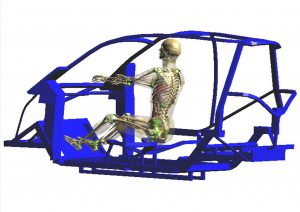
The reliability of electrical conductivity data for human tissues is considered to be poorer for low frequencies than for frequencies above 1 MHz [18]. The electrical properties used in these models were as supplied by SEMCAD [19]. The internal electric field and current density induced in the tissues were computed (from 1 Hz to 2.5 kHz) using the SEMCAD X ELF quasi-static field solver [20]. As the latter is not able to include metallic structures in magnetic field simulations, only the traction current paths are represented in the models. This is representative of vehicles with non-conducting body panels. For vehicles with steel body panels, however, the in-vehicle exposure is expected to be smaller than this [5].
Two source configurations representing typical magnetic field exposure scenarios due to traction current paths in hybrid and electric vehicles were investigated in [21]. The first configuration was a simple single-phase high-voltage cable passing under the driver. This scenario is found in a number of hybrid and electric vehicles with traction batteries mounted in the rear of the vehicle and a motor and inverter collocated at the front. A single-phase high-voltage power cable then passes beneath the passenger compartment. In the first test case, therefore, a straight horizontal pair of cables carrying oppositely directed currents of equal magnitude is assumed to pass below the axis of the seated human model. The currents were placed at a distance of 5 cm below the lowest point of the body (the heels). The current paths are assumed to be closely-spaced (14 mm apart, as representative of automotive high-voltage cable diameters) to minimize their magnetic field, although larger conductor separations can be found in vehicles.
The second configuration was a more complex high-voltage power network, representing a traction battery as well as two single-phase cables linking the battery to inverters at the front and rear axles (based on initial designs for a small electric vehicle developed in the FP7 European project PMOB [16]). The traction battery was configured from a number of modules that were initially arranged in a U-shape and linked together in serial fashion, thus forming a large current loop located below the driver’s seat (see Fig. 5). The electrical energy was also distributed in single-phase form to inverters and motors mounted on the front and rear axles. This created three major traction current loops in the vehicle. For the purposes of the simulations the battery current was assumed to be equal to the sum of the two inverter currents. The latter were also assumed to be identical in magnitude but oppositely directed, such that the magnetic field from one of the inverter loops was oppositely directed to the fields of the battery loop and the second inverter loop.
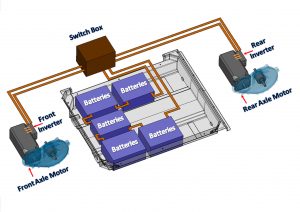
In real-world driving the speed and load demands are constantly varying, resulting in complex time-varying magnetic field exposures. Consequently, a current waveform measured during a short driving cycle in a small (10 kW) electric vehicle was used in order to estimate the magnetic field exposure under realistic driving conditions (including acceleration and deceleration) for both of the test cases. The current waveform is shown in Fig. 6, while Fig. 7 shows the vertical component of the in-vehicle magnetic field, which was measured concurrently.
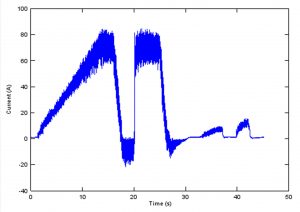
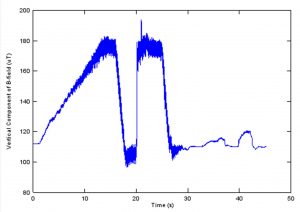
The magnetic field amplitude distributions resulting from the source test cases over the region occupied by the driver model are illustrated in Figs. 8–9, for the two source test cases. Results were also obtained for a flat three-phase cable configuration, with the same conductor spacing as the single phase case. This arrangement is also of practical importance as such cables are found in hybrid and electric vehicles that have an inverter collocated with the battery at the rear, while the motor is mounted at the front. However, the three-phase results were almost identical to those reported here for the single-phase case.
The field exposures are highly non-uniform, with maximum values reaching around four times the average values. For the purposes of this investigation, therefore, the maximum values of both the induced electric field and the current density were collected from the human model (for frequencies up to 3 kHz) for both of the source configurations using an arbitrary excitation level (1 A). These were all found to occur in the location of the lower part of the trunk of the seated human model.
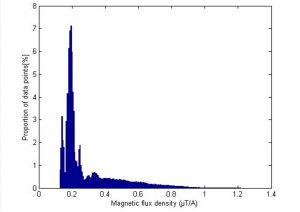
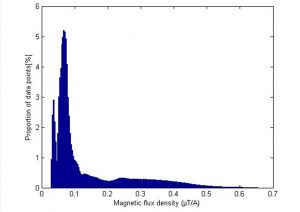
COMPARISON OF BASIC RESTRICTION RESULTS
The results obtained from time-domain evaluations of the magnetic flux density and of the induced current density and internal electric field in the driver model are summarized in Table 1 for the two source configurations. This details the maximum values of the corresponding time-varying exposure measures derived from the measured current waveform, expressed as a percentage of the field reference levels or basic restrictions as appropriate. It also includes projected values for the basic restrictions that would be expected if the field reference level measures were to reach 100%.

For both source test cases the time-varying exposure measures obtained for the basic restrictions using the measured traction current waveform were below 100% for both of the ICNIRP limits. For the single cable source, the exposure reached only 62% of the ICNIRP 1998 basic restrictions, and indicates that the ICNIRP 1998 field reference levels provide a safety factor as the basic restrictions were estimated to be around 17.5% for exposures that reach 100% of the field reference levels. However, the data based on the ICNIRP 2010 limits reach a smaller proportion of the field reference levels (24.4%) than of the basic restrictions (26.45%), based on the measured current waveform. For exposure at 100% of the reference levels, the projected basic restriction value would reach 108.35%, indicating that the more relaxed field reference levels of ICNIRP 2010 may not provide reliable protection for the basic restrictions for in-vehicle exposure scenarios.
For the battery and cable source configuration, the maximum exposures relative to the field reference levels were higher than the basic restrictions for both ICNIRP 1998 and ICNIRP 2010 (see Table 1). For this test case, therefore, both sets of field reference levels achieved their goal of ensuring that the corresponding basic restrictions were not breached.
Possible concerns about the effectiveness of the ICNIRP 2010 field reference levels have also been reported in relation to some standing models under uniform magnetic field exposures [22]. The models described above have also been used to investigate the relationship between the basic restrictions and the field reference levels for frequencies up to 2.5 kHz [23]. This provides an indication of the safety margins that the reference levels provide for single frequency sources.
The threshold magnetic field levels at which the basic restrictions of ICNIRP 1998 and ICNIRP 2010 would be reached for the single-phase cable source are shown in Fig. 10, which also shows the field reference levels. For this source the ICNIRP 1998 reference levels are lower than the threshold magnetic flux densities for both induced current density (the ICNIRP 1998 basic restriction parameter) and internal electric field (the ICNIRP 2010 basic restriction parameter). Above about 400 Hz, the threshold fields for the ICNIRP 2010 basic restrictions are only slightly higher than the field reference levels.
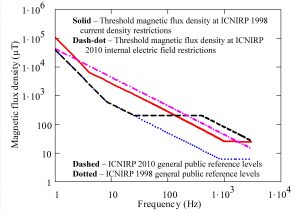
For the battery source configuration, the ICNIRP 1998 reference levels are again lower than the threshold magnetic fields for both current density and internal electric field (see Fig. 11). However, the ICNIRP 2010 reference levels are higher than the field thresholds for internal electric field above about 220 Hz.
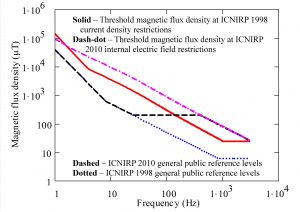
OTHER CONSIDERATIONS RELATING TO EXPOSURE LEVELS
It should be noted that the ICNIRP recommendations only aim to provide protection against well-established acute physiological effects such as electro-stimulation and tissue heating (the latter for frequencies above 100 kHz). The ICNIRP view regarding chronic effects [13] is that, that while there is consistent epidemiological evidence for an association between childhood leukaemia and power frequency magnetic field exposure (at levels of around 0.3–0.4 µT), a satisfactory causal relationship has yet to be reliably demonstrated. Consequently, ICNIRP regard the evidence for this, and for other possible chronic effects that have been reported, to be too weak to provide a reliable basis for setting field exposure guidelines. Nonetheless, some governments have chosen to set limits for electromagnetic exposure that are intended to provide protection against possible chronic effects, and these are at significantly lower levels than the ICNIRP 1998 general public recommendations.
The World Health Organization (WHO) also consider that the evidence for chronic effects is currently weak and that the health benefits of reducing low frequency magnetic field exposure remain unclear [24]. However, the WHO also recommend the adoption of a precautionary approach, including the consideration of low frequency magnetic field exposure in system design, and possible implementation of field mitigation measures where this can be achieved at low cost and without compromising system performance.
In addition, the EMC requirements for artificial implantable medical devices ([25]–[28]) include immunity requirements that are in part based on the ICNIRP 1998 field reference levels, since the general public were not expected to be exposed to field levels that exceeded the ICNIRP 1998 recommendations. However, this means that the immunity performance of such devices is essentially unknown in field environments that comply with the ICNIRP 2010 recommendations for general public exposure, but exceed the ICNIRP 1998 field reference levels.
CONCLUSIONS
Time-varying low frequency magnetic fields with significant spatial variability are generated in vehicles with electrical powertrains due to high rates of change of traction current on the high voltage power network during driving. Engine cranking operations also produce similar effects in vehicles equipped with combustion engines, and these events now occur routinely during driving for modern cars with stop-start capabilities. Thus, there is a need to consider possible occupant field exposure issues in vehicle design, and to take measures to reduce in-vehicle field levels if necessary.
Simply comparing the magnetic field at each frequency with the corresponding field reference level is not sufficient to evaluate possible human exposure risks. For broadband exposures, such as those produced by traction current waveforms, there is a need to take account of additive effects when assessing human exposure. Furthermore, the spatial field distribution that the occupants are exposed to, which results from electrical powertrain components in relatively close proximity, is not easy to characterize. Suitable methods for measuring and evaluating in-vehicle magnetic field exposure, as well as bystander exposure, are now being considered in the development of the new standard IEC 62764–1 [8]. However, the selection of appropriate limits to be applied in evaluating in-vehicle low frequency magnetic field exposure remains an open question.
The general public exposure class described by ICNIRP would probably be applicable for most vehicle applications. However, it is not certain that the more recent ICNIRP 2010 recommendations [13] are equally applicable in all exposure scenarios. The results reported here, based on simulations of a seated human under exposures that are representative of traction current magnetic fields in hybrid and electric vehicles, suggest that the ICNIRP 2010 field reference levels may not provide a reliable safety margin for the basic restrictions. However, the ICNIRP 1998 field reference levels [9] provided substantial safety margins in terms of both induced current density and internal electric field. Given the nature of in-vehicle exposures and the difficulties of characterizing in-vehicle magnetic fields, there is a need to be cautious in evaluating the possible threat. Furthermore, the EMC requirements of artificial implantable medical devices are partly based around the ICNIRP 1998 field reference levels. Consequently, evaluating the highest field levels against the ICNIRP 1998 reference levels would perhaps give greater confidence for assessing the risks of acute magnetic field exposure effects.
Nonetheless, there may also be a need to assess in-vehicle magnetic field exposure against requirements that are even lower than ICNIRP 1998, which are intended to protect against possible chronic exposure effects. Given the global nature of the automotive industry, vehicles may need to comply with the lowest magnetic field exposure requirements in order to ensure that they can be successfully marketed in all territories.
ACKNOWLEDGEMENT
The research leading to these results has received funding from the European Community’s Framework Programme (FP7/2007-2013) under grant agreements nº 265772 and nº 314609.
REFERENCES
[1] J. de Santiago et al., “Electrical motor drivelines in commercial all-electric vehicles: a review”, IEEE Transactions of Vehicular Technology., Vol. 61, No. 2, 475–484, February 2012.
[2] F. M. Dietrich and W. L. Jacobs, “Survey and assessment of electric and magnetic field (EMF) public exposure in the transportation environment”, US Department of Transportation, Federal Railroad Administration, Report No. PB99-130908, March 1999.
[3] G. Schmid, R. Überbacher and P. Göth, “ELF and LF magnetic field exposure in hybrid- and electric cars”, Proceedings of Bio-electromagnetics Conference 2009, Davos, Switzerland, June 2009, Paper 9–3.
[4] A. R. Ruddle, L. Low and A. Vassilev, “Evaluating low frequency magnetic field exposure from traction current transients in electric vehicles”, Proceedings of 12th International European Symposium on EMC, Bruges, Belgium, September 2013, pp. 78–83.
[5] A.R. Ruddle and L. Low, “Impact of bodyshell on low frequency magnetic fields due to electric vehicle power cables”, Proceedings of 11th International European Symposium on EMC, Rome, Italy, September 2012.
[6] S. Milham, J. B. Hatfield, and R. Tell, “Magnetic fields from steel-belted radial tires: implications for epidemiologic studies” Bioelectromagnetics, Vol. 20, No. 7, pp. 440–445, 1999.
[7] CENELEC, EN 50500:2008, “Measurement procedures of magnetic field levels generated by electronic and electrical apparatus in the railway environment with respect to human exposure”, August 2008.
[8] IEC 62764–1, “Measurement procedures for low frequency magnetic field in the automotive environment with respect to human exposure”, currently under development, forecast publication date March 2016 (http://www.iec.ch/dyn/www/f?p=103:23:0::::FSP_ORG_ID:1303).






